

Forced Convection. Nusselt Number. Convection, wikipedia. Convection is the concerted, collective movement of groups or aggregates of molecules within fluids (e.g., liquids, gases) and rheids, either through advection or through diffusion or as a combination of both of them.
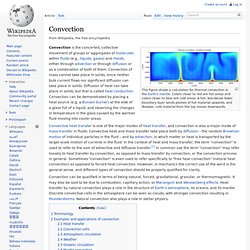
Convection of mass cannot take place in solids, since neither bulk current flows nor significant diffusion can take place in solids. Diffusion of heat can take place in solids, but that is called heat conduction. Convection can be demonstrated by placing a heat source (e.g. a Bunsen burner) at the side of a glass full of a liquid, and observing the changes in temperature in the glass caused by the warmer fluid moving into cooler areas. Convection (Temperature Control & Ventilation Systems) Transport Phenomena.
Category:Transport phenomena. Category:Thermodynamics. Urban thermal plume. An urban thermal plume describes rising air in the lower altitudes of the Earth's atmosphere caused by urban areas being warmer than surrounding areas.
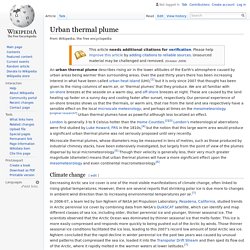
Over the past thirty years there has been increasing interest in what have been called urban heat island (UHI),[1] but it is only since 2007 that thought has been given to the rising columns of warm air, or ‘thermal plumes’ that they produce. We are all familiar with on-shore breezes at the seaside on a warm day, and off-shore breezes at night.
Turbulent Prandtl number. The turbulent Prandtl number (Prt) is a non-dimensional term defined as the ratio between the momentum eddy diffusivity and the heat transfer eddy diffusivity.
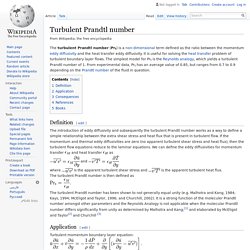
It is useful for solving the heat transfer problem of turbulent boundary layer flows. The simplest model for Prt is the Reynolds analogy, which yields a turbulent Prandtl number of 1. From experimental data, Prt has an average value of 0.85, but ranges from 0.7 to 0.9 depending on the Prandtl number of the fluid in question. Thermosiphon. Thermosyphon circulation in a simple solar water heater Thermosiphon (or thermosyphon) is a method of passive heat exchange, based on natural convection, which circulates a fluid without the necessity of a mechanical pump.

Thermosiphoning is used for circulation of liquids and volatile gases in heating and cooling applications such as heat pumps, water heaters, boilers and furnaces. Thermosiphoning also occurs across air temperature gradients such as those utilized in a wood fire chimney or solar chimney. This circulation can either be open-loop, as when the substance in a holding tank is passed in one direction via a heated transfer tube mounted at the bottom of the tank to a distribution point—even one mounted above the originating tank—or it can be a vertical closed-loop circuit with return to the original container.
Thermomagnetic convection. Ferrofluids can be used to transfer heat, since heat and mass transport in such magnetic fluids can be controlled using an external magnetic field.
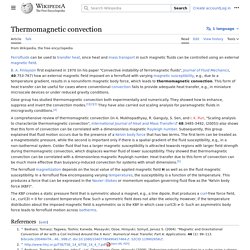
B. A. Finlayson first explained in 1970 (in his paper "Convective instability of ferromagnetic fluids", Journal of Fluid Mechanics, 40:753-767) how an external magnetic field imposed on a ferrofluid with varying magnetic susceptibility, e.g., due to a temperature gradient, results in a nonuniform magnetic body force, which leads to thermomagnetic convection. Texas Norther. A Texas Norther, also known as a blue norther, is a cold front in the U.S. state of Texas, marked by a sudden drop in temperature (sometimes up to 25 degrees F within one hour), heavy precipitation, and dark blue skies moving across the state.
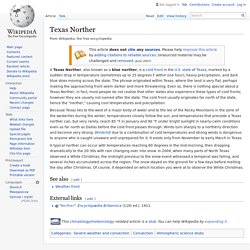
The phrase originated within Texas, where the land is very flat, perhaps making the approaching front seem darker and more threatening. Even so, there is nothing special about a Texas Norther; in fact, most people do not realize that other states also experience these types of cold fronts; however they are usually not named after the state. The cold front usually originates far north of the state, hence the "norther," causing cool temperatures and precipitation. A typical norther can occur with temperatures reaching 60 degrees in the mid-morning, then dropping dramatically to the 20-30s with rain changing over into snow. See also[edit] Weather front External links[edit] "Norther". Reynolds number. Dimensionless quantity used to help predict fluid flow patterns The plume from this candle flame goes from laminar to turbulent.
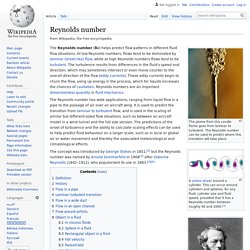
The Reynolds number can be used to predict where this transition will take place. A vortex street around a cylinder. This can occur around cylinders and spheres, for any fluid, cylinder size and fluid speed, provided that it has a Reynolds number between roughly 40 and 1000. The Reynolds number has wide applications, ranging from liquid flow in a pipe to the passage of air over an aircraft wing. The concept was introduced by George Stokes in 1851, but the Reynolds number was named by Arnold Sommerfeld in 1908 after Osborne Reynolds (1842–1912), who popularized its use in 1883.
Definition[edit] The Reynolds number is the ratio of inertial forces to viscous forces within a fluid which is subjected to relative internal movement due to different fluid velocities. With respect to laminar and turbulent flow regimes: Rayleigh number. In fluid mechanics, the Rayleigh number (Ra) for a fluid is a dimensionless number associated with buoyancy-driven flow, also known as free convection or natural convection.
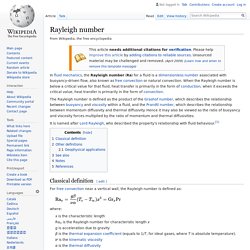
When the Rayleigh number is below a critical value for that fluid, heat transfer is primarily in the form of conduction; when it exceeds the critical value, heat transfer is primarily in the form of convection. The Rayleigh number is defined as the product of the Grashof number, which describes the relationship between buoyancy and viscosity within a fluid, and the Prandtl number, which describes the relationship between momentum diffusivity and thermal diffusivity. Hence it may also be viewed as the ratio of buoyancy and viscosity forces multiplied by the ratio of momentum and thermal diffusivities. It is named after Lord Rayleigh, who described the property's relationship with fluid behaviour.[1] Classical definition[edit]
Prandtl number. The Prandtl number (Pr) or Prandtl group is a dimensionless number, named after the German physicist Ludwig Prandtl, defined as the ratio of momentum diffusivity to thermal diffusivity.[1] That is, the Prandtl number is given as: where: : momentum diffusivity (kinematic viscosity), , (SI units: m2/s) : thermal diffusivity, , (SI units: m2/s) : dynamic viscosity, (SI units: Pa s = N s/m2) : thermal conductivity, (SI units: W/m-K) : specific heat, (SI units: J/kg-K) : density, (SI units: kg/m3).

Note that whereas the Reynolds number and Grashof number are subscripted with a length scale variable, the Prandtl number contains no such length scale in its definition and is dependent only on the fluid and the fluid state. Péclet number. The Péclet number (Pe) is a class of dimensionless numbers relevant in the study of transport phenomena in a continuum.

It is named after the French physicist Jean Claude Eugène Péclet. It is defined to be the ratio of the rate of advection of a physical quantity by the flow to the rate of diffusion of the same quantity driven by an appropriate gradient. In the context of species or mass transfer, the Péclet number is the product of the Reynolds number and the Schmidt number. In the context of the thermal fluids, the thermal Peclet number is equivalent to the product of the Reynolds number and the Prandtl number. Nusselt number. A Nusselt number close to one, namely convection and conduction of similar magnitude, is characteristic of "slug flow" or laminar flow. A larger Nusselt number corresponds to more active convection, with turbulent flow typically in the 100–1000 range. where h is the convective heat transfer coefficient of the flow, L is the characteristic length, k is the thermal conductivity of the fluid.
Selection of the characteristic length should be in the direction of growth (or thickness) of the boundary layer; some examples of characteristic length are: the outer diameter of a cylinder in (external) cross flow (perpendicular to the cylinder axis), the length of a vertical plate undergoing natural convection, or the diameter of a sphere.
Natural convection. Natural convection is a mechanism, or type of heat transport, in which the fluid motion is not generated by any external source (like a pump, fan, suction device, etc.) but only by density differences in the fluid occurring due to temperature gradients. In natural convection, fluid surrounding a heat source receives heat, becomes less dense and rises. The surrounding, cooler fluid then moves to replace it. This cooler fluid is then heated and the process continues, forming a convection current; this process transfers heat energy from the bottom of the convection cell to top. The driving force for natural convection is buoyancy, a result of differences in fluid density. Because of this, the presence of a proper acceleration such as arises from resistance to gravity, or an equivalent force (arising from acceleration, centrifugal force or Coriolis effect), is essential for natural convection.
Marklund convection. Mechanism[edit] In Marklund's paper, the plasma convects radially inwards towards the center of a cylindrical flux tube. During this convection, the different chemical constituents of the plasma, each having its specific ionization potential, enters into a progressively cooler region. The plasma constituents will recombine and become neutral, and thus no longer under the influence of the electromagnetic forcing. The ionization potentials will thus determine where the different chemicals will be deposited.[1] This provides an efficient means to accumulate matter within a plasma.[2] In a partially ionized plasma, electromagnetic forces act on the non-ionized material indirectly through the viscosity between the ionized and non-ionized material. Marangoni effect. History[edit] Mechanism[edit] Marangoni effect experimental demonstration. Mantle convection. This subducted material sinks to a depth of 660 kilometres (410 mi) in the Earth's interior where it is impeded from sinking further, possibly due to a phase change from spinel to silicate perovskite and magnesiowustite, an endothermic reaction.[6] The subducted oceanic crust triggers volcanism, although the basic mechanisms are varied.
Volcanism may occur due to processes that add buoyancy to partially melted mantle causing an upward flow due to a decrease in density of the partial melt. Secondary forms of convection that may result in surface volcanism are postulated to occur as a consequence of intraplate extension[7] and mantle plumes.[1] It is because the mantle can convect that the tectonic plates are able to move around the Earth's surface.[8] Types of convection[edit] Laboratory oven. Grashof number. Granular convection. Brazil nuts ride on top of other assorted nuts Granular convection is a phenomenon where granular material subjected to shaking or vibration will exhibit circulation patterns similar to types of fluid convection.[1] It is sometimes described as the Brazil nut effect when the largest particles end up on the surface of a granular material containing a mixture of variously sized objects; this derives from the example of a typical container of mixed nuts, where the largest will be Brazil nuts.
The phenomenon is also known as the muesli effect since it is seen in packets of breakfast cereal containing particles of different sizes but similar density, such as muesli mix. Under experimental conditions, granular convection of variously sized particles has been observed forming convection cells similar to fluid motion.[2][3] The convection of granular flows is becoming a well-understood phenomenon.[4] Explanation[edit] Convective overturn. Convection zone. Convection oven. A convection oven (also known as a fan-assisted oven or simply a fan oven) is an oven that has fans to circulate air around food.[1] Conventional ovens, which do not have fans, rely primarily on radiation from the oven walls, and to a lesser extent, on natural convection caused by temperature differences within the oven, to transfer heat to food.
In contrast, the fans in convection ovens allow more heat to be transferred via convective heat transfer.[2] Convection ovens distribute heat evenly around the food, removing the blanket of cool air that surrounds food in an oven, allowing food to cook more evenly in less time and at a lower temperature than in a conventional oven.[3] Convection microwave. Cold hole. Coffee ring effect. Churchill–Bernstein equation. Rayleigh–Bénard convection. Bejan number. Annualized geo solar. Advection. Category:Severe weather and convection. Heat Transport (Thermodynamics)